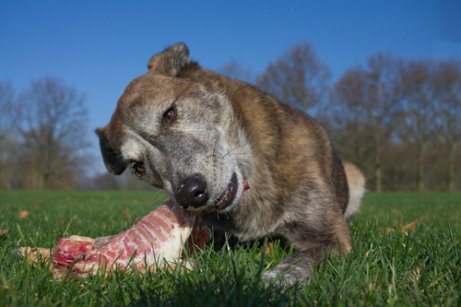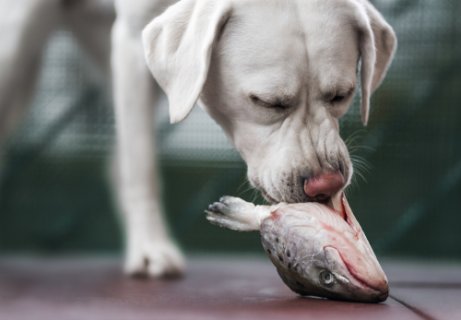What's The Best Type Of Meat For Your Dog?

As a pet owner, you know that a good diet is essential for pets. Therefore, here you can take a look at some of the best foods that can help you come up with a diet that suits your pet’s needs. When making these choices, you should ask yourself: what is the best type of meat for my dog?
You should consider many factors: the breed and size of the dog, the cut and type of meat. Let’s take a look at the benefits that meat offers to your dog.
A Natural Diet
Currently, there is a myth that says dogs shouldn’t eat meat because they will develop a taste for blood. This could not be further from the truth. Dogs are carnivorous animals by nature. Therefore, eat different types of meat is important for their diet.
Just like wolves, dogs don’t have a problem digesting raw meat. In some cases, they can even digest rotten meat. However, dogs have more difficulties eating cooked meat because it does not have many of the natural benefits that raw meat has.
Dogs have a very different digestive tract from humans. They can’t digest the same things as us, such as cooked meat. Look at the BARF diet because it recommends different varieties of meat.
What is the best type of meat for your dog?
As you already know, there are several animals that provide food to other animals and humans. Human beings have developed a system for producing high-quality meat for food.
This same principle applies to feed pets. You can get meat for your dog from pigs, cows, lambs, or even rabbits and birds. You just need to decide what is the best type of meat for your dog in terms of nutrition.

First of all, we need to make something clear. Lean meat is always best to feed dogs. However, this doesn’t mean they can’t eat fat and viscera. In nature, animals have to take advantage of every food source they can get.
After taking this into consideration, you can evaluate what is the best type of meat for your dog. There are some meats that provide more beneficial oils (such as fish oil and omega-3). However, other meats provide more protein or fats.
What’s the best meat?
Giving one clear answer to this question is complicated. As mentioned earlier, different types of meat have different compositions. This means each one has benefits and downsides.
For example, if you want your to dog to have a diet rich in protein, the popular belief is that red meats are a good option. On the contrary, red meats provide aren’t so balanced in protein and have high-fat levels, which can be harmful to certain breeds.
If you want more protein, it would be better to give your dog is fish. Fish is a natural source of omega-3, which is good for your dog’s fur. Plus, it’s very low in fat, which can help prevent digestive problems.
Unlike meat from mammals, fish must be cleaned before it’s eaten. We recommend submerging it in hot water for a few minutes to eliminate any toxins.

Types of Meat Based on Breed
When it comes to giving your dog meat, you should take several factors into consideration. For example, the size of your dog is important.
Larger breeds require more fat and protein to maintain their physique. Small breeds need food with less fat, so birds and fish are a great option for them.
While some cuts are better than others for your dog, you shouldn’t forget you have to vary their food every so often. This will help your dog from getting bored or irritated from always eating the same thing.
No matter what, if you want to provide good quality food, the best thing you can do is ask your dog’s veterinarian about what meat would be best for your dog. They will know what is best for your pet and give you advice on choosing the right meat for your dog.
As a pet owner, you know that a good diet is essential for pets. Therefore, here you can take a look at some of the best foods that can help you come up with a diet that suits your pet’s needs. When making these choices, you should ask yourself: what is the best type of meat for my dog?
You should consider many factors: the breed and size of the dog, the cut and type of meat. Let’s take a look at the benefits that meat offers to your dog.
A Natural Diet
Currently, there is a myth that says dogs shouldn’t eat meat because they will develop a taste for blood. This could not be further from the truth. Dogs are carnivorous animals by nature. Therefore, eat different types of meat is important for their diet.
Just like wolves, dogs don’t have a problem digesting raw meat. In some cases, they can even digest rotten meat. However, dogs have more difficulties eating cooked meat because it does not have many of the natural benefits that raw meat has.
Dogs have a very different digestive tract from humans. They can’t digest the same things as us, such as cooked meat. Look at the BARF diet because it recommends different varieties of meat.
What is the best type of meat for your dog?
As you already know, there are several animals that provide food to other animals and humans. Human beings have developed a system for producing high-quality meat for food.
This same principle applies to feed pets. You can get meat for your dog from pigs, cows, lambs, or even rabbits and birds. You just need to decide what is the best type of meat for your dog in terms of nutrition.

First of all, we need to make something clear. Lean meat is always best to feed dogs. However, this doesn’t mean they can’t eat fat and viscera. In nature, animals have to take advantage of every food source they can get.
After taking this into consideration, you can evaluate what is the best type of meat for your dog. There are some meats that provide more beneficial oils (such as fish oil and omega-3). However, other meats provide more protein or fats.
What’s the best meat?
Giving one clear answer to this question is complicated. As mentioned earlier, different types of meat have different compositions. This means each one has benefits and downsides.
For example, if you want your to dog to have a diet rich in protein, the popular belief is that red meats are a good option. On the contrary, red meats provide aren’t so balanced in protein and have high-fat levels, which can be harmful to certain breeds.
If you want more protein, it would be better to give your dog is fish. Fish is a natural source of omega-3, which is good for your dog’s fur. Plus, it’s very low in fat, which can help prevent digestive problems.
Unlike meat from mammals, fish must be cleaned before it’s eaten. We recommend submerging it in hot water for a few minutes to eliminate any toxins.

Types of Meat Based on Breed
When it comes to giving your dog meat, you should take several factors into consideration. For example, the size of your dog is important.
Larger breeds require more fat and protein to maintain their physique. Small breeds need food with less fat, so birds and fish are a great option for them.
While some cuts are better than others for your dog, you shouldn’t forget you have to vary their food every so often. This will help your dog from getting bored or irritated from always eating the same thing.
No matter what, if you want to provide good quality food, the best thing you can do is ask your dog’s veterinarian about what meat would be best for your dog. They will know what is best for your pet and give you advice on choosing the right meat for your dog.
All cited sources were thoroughly reviewed by our team to ensure their quality, reliability, currency, and validity. The bibliography of this article was considered reliable and of academic or scientific accuracy.
- Fascetti, A. J., & Delaney, S. J. (2013). Feeding the Healthy Dog and Cat. In Applied Veterinary Clinical Nutrition. https://doi.org/10.1002/9781118785669.ch7
- Freeman, L. M., Chandler, M. L., Hamper, B. A., & Weeth, L. P. (2013). Current knowledge about the risks and benefits of raw meat–based diets for dogs and cats. Journal of the American Veterinary Medical Association. https://doi.org/10.2460/javma.243.11.1549
- Sillero, M. (2019) Mitos y dietas alternativas en perros y gatos. Revisión sobre sus efectos y recomendaciones. (Tesis de grado, Universidad Católica de Valencia). Recuperado el 17 de marzo de 2022, disponible en: https://riucv.ucv.es/bitstream/handle/20.500.12466/58/Mara_Sillero_Vizcaino_pdf.pdf?sequence=5
- Loaiza, M., Loaiza, L. & López, A. (2018) Diseño de dietas BARF para perros en tres etapas fisiológicas. (Tesis de Grado, Universidad Tecnológica de Pereira). Recuperado el 17 de marzo de 2022, disponible en: https://core.ac.uk/download/pdf/158348432.pdf
- Rejas López, Juan (2008). Dermatitis y reacciones adversas a los alimentos. REDVET. Revista Electrónica de Veterinaria, IX(5),1-16. Recuperado el 17 de marzo de 2022, disponible en: https://www.redalyc.org/articulo.oa?id=63611397009
This text is provided for informational purposes only and does not replace consultation with a professional. If in doubt, consult your specialist.








